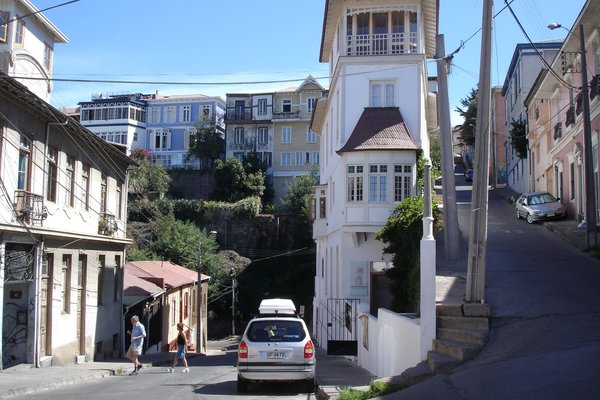Chile
Valparaiso
The Historic Quarter of the Seaport City of Valparaiso testifies to Valparaiso's leading position as a merchant port in the late 19th century.
Valparaiso played an important role on the Pacific Coast during the early phase of globalisation, before the opening of the Panama Canal. The geographic location on steep hills and the different nationalities of the inhabitants have led to a distinct and innovative urban landscape.
Community Perspective: some of our reviewers were more bothered than others by the fact that Valparaiso's best days clearly are behind it. But the historic elevators to travel between the lower and upper parts are a joy, and the maze of stairs and alleys in the upper town are the highlights of a visit.
Site Info
Official Information
- Full Name
- Historic Quarter of the Seaport City of Valparaiso (ID: 959)
- Country
- Chile
- Status
-
Inscribed 2003
Site history
History of Valparaiso
- 2003: Inscribed
- Inscribed
- 2000: Requested by State Party to not be examined
- As "Historic Quarter of the Seaport City of Vaparaíso"
- Type
- Cultural
- Criteria
- iii
Links
- UNESCO
- whc.unesco.org
- Official
-
- valparaiso.com — Ciudad de Valparaiso
All Links
UNESCO.org
- whc.unesco.org — whc.unesco.org/
Official Website
- valparaiso.com — Ciudad de Valparaiso
News Article
- Jan. 6, 2023 bloomberg.com — Valparaiso’s Decline Leaves Unesco World Heritage Site Graffitied, Crumbling
- April 15, 2014 huffingtonpost.com — Blaze threatening Valparaiso's historic port
- Feb. 13, 2014 ndtv.com — Mall project threatens Valparaiso's old world charm
- March 5, 2010 whc.unesco.org — Significant structural damage in Valparaiso at the La Matriz church and the Port market place
- March 1, 2010 examiner.com — Chile earthquake damages unique world heritage city of Valparaiso
- Feb. 10, 2007 un.org — UNESCO offers help to restore burned down World Heritage Site in Chile
Community Information
- Community Category
- Urban landscape: Maritime
Travel Information
Recent Connections
-
Exchanges or Bourses
The Edificio de la Bolsa de Valparaíso …
-
Anglican churches outside of the Commonwealth
St Pauls Cathedral: "Built in the year … -
Art Nouveau
Palacio BarburizzaSee en.wikipedia.org
Connections of Valparaiso
- Individual People
-
-
Charles Darwin
July 23rd. ..The Beagle anchored late at night in the bay of Valparaiso, the chief seaport of Chile (1834)
-
- Geography
- Trivia
-
-
Built or owned by Germans
Cerro Alegre and Cerro Concepción, a single neighbourhood planned and developed to a large extent by German and English immigrants, with squares, viewing points, promenades, alleyways, stairways and the top stations of some of Valparaíso’s distinctive funicular elevators. (Unesco) -
Built or owned by British
Cerro Alegre and Cerro Concepción, a single neighbourhood planned and developed to a large extent by German and English immigrants, with squares, viewing points, promenades, alleyways, stairways and the top stations of some of Valparaíso’s distinctive funicular elevators. (Unesco)
-
- Architecture
-
-
Vernacular architecture
"the city is characterized by a vernacular urban fabric" (unesco website) -
Art Nouveau
Palacio BarburizzaSee en.wikipedia.org
-
Art Deco
Several buildings in the Upper Town, some now turned into hotels -
Urban fabric
-
Italian Architects outside Italy
Museo de Bellas Artes - Arnaldo Barison and Renato Schiavoni
-
- Damaged
-
-
Cultural sites damaged by fire since inscription
City Centre - Feb 2007 -
Destroyed or damaged by Earthquake
(Aug 17 1906, May 22 1960)
-
- World Heritage Process
-
-
Inscribed on a single criterion only
iii. to bear a unique or at least exceptional testimony to a cultural tradition or to a civilization which is living or which has disappeared -
Extended from original TWHS
From Historic Quarter of the Seaport City of Vaparaíso -
Reduced from broader TWHS
Historic Quarter of the Seaport City of Vaparaíso
-
- Religion and Belief
-
-
Protestantism
Saint Paul's Anglican Church. "The exceptional historic value of this building is closely related to its austerity, determined by the context in which it was built, when the ban on the public exercise of different creeds other than the Catholic was in full force. This church, of neo-Romanesque and neo-Gothic features, sought to keep a low profile by means of an horizontal design, the absence of a tower, the lateral accesses and the low fence that surrounds it." (Nom File) -
Anglican churches outside of the Commonwealth
St Pauls Cathedral: "Built in the year 1858 in Cerro Concepción, the first of its type in Chile, it was born from the efforts of the Anglican Community installed in Valparaíso of the XIX century."
-
- Human Activity
-
-
Historical Financial Institutions
Bolsa de Corredores de Valparaiso (1892)See es.wikipedia.org
-
Sea Ports
-
Human Migration
Consistent with its pre-eminence, the city was populated and influenced by people from around the world. The urban fabric and cultural identity of Valparaíso are thus distinguished by a diversity that sets it apart from other Latin American cities. (Unesco website)
-
- Constructions
-
-
Exchanges or Bourses
The Edificio de la Bolsa de Valparaíso (1911–1915), a five-story neoclassical building with a distinctive cylindrical corner and French-style cupola, operated as Latin America's first dedicated securities exchange until the 1980s, reflecting Valparaíso's port-driven financial boom; . Projected modern port-finance prestige in Latin America Is now a historic monument used for offices and events, viewable externally with limited interior access for visitors on request. (wiki es)
-
Funiculars
7 are still in useSee en.wikipedia.org
-
Elevators
Ascensor Polanco
-
- WHS on Other Lists
-
-
World Monuments Watch (past)
Elevators (1996), Elevators of Valparaíso (2014)See www.wmf.org
-
- Timeline
-
-
Built in the 19th Century
exceptional testimony to the early phase of globalization in the late 19th century (AB ev)
-
- Literature & Film
-
-
Works by Nobel Prize winning authors
Pablo Neruda (1971) - "Oda a Valparaiso"
-
News
- bloomberg.com 01/06/2023
- Valparaiso’s Decline Leaves Unesco…
- huffingtonpost.com 04/15/2014
- Blaze threatening Valparaiso's his…
- ndtv.com 02/13/2014
- Mall project threatens Valparaiso'…
Recent Visitors
Visitors of Valparaiso
- AC
- Adrian Turtschi
- Alberto Rodriguez Gutierrez
- Alejandro Lau
- Alexander Lehmann
- Alexander Parsons
- AlexSchedel
- Allan Berry
- ALS
- Alvaro1404
- A. Mehmet Haksever
- Ammon Watkins
- Ana
- Andrew0181
- Anna Wludarska
- Argo
- Artur Anuszewski
- Atila Ege
- AYB
- Badwater
- basementonline
- BaziFettehenne
- Bill Maurmann
- Carlo Medina
- Carlos Sotelo
- Celina Nanbara
- Cezar Grozavu
- Chantal den Haan
- Cheryl
- Chinmaya
- chiuliqi
- Cirene Moraes
- Claire Bradshaw
- Clyde
- Corinne Vail
- Csaba Nováczky
- ctravel
- Cyberczar
- CynthiaW
- Daniela Hohmann
- Dan Pettigrew
- David Scott King
- Delphine Delaunay
- Dimitrios Polychronopoulos
- DjhMck
- DouglasR
- Dwight Zehuan Xiao
- edstar500
- Ellen Nielsen
- Els Slots
- Emili Xaus
- Eva Kisgyorgy
- Fan Yibo
- Feldhase
- Felicité
- Fernweh
- Filip Murlak
- Frederik Dawson
- George Gdanski
- Gernot
- Gilles
- giloudepuertorico
- Grendel Gongan
- Grzegorz Andruszkiewicz
- Hadrianus
- HaraldOest
- Harald T.
- Harry Mitsidis
- H Beswick
- Hdwilsonau
- hotpickle
- Hunstow
- Iain Jackson
- IreneKD
- Jacob Otten
- Jan Zimmermann
- Jarek Pokrzywnicki
- Jawnbeary
- Jay T
- Jens
- J_neveryes
- João Aender
- Jonas Kremer
- JoStof
- JR's HERITAGE SITES
- KateY
- Kbecq
- KeithBailey
- Kevin247
- kiank37
- Kjlauer
- Krijn
- Kurt Lauer
- Lauren Gurnee
- Linz
- Loic Pedras
- Lucas Del Puppo
- Luis Filipe Gaspar
- Maciej Gil
- Malgorzata Kopczynska
- manuel011197
- Marcobrey
- Martin
- maryhattie
- M. Huineman
- Michael Ayers
- Michael Novins
- Michael Turtle
- Mihai Dascalu
- Mikko
- MMM
- Monica Tasciotti
- Morodhi
- Mozzer76
- nan
- natlefebvre@hotmail.
- NH1984
- Nick Kuzmyak
- Nicolas
- Nicole Lampos
- Nihal Ege
- Patrik
- Patrik_globe
- Peltzi
- phillipmeng
- Pieter Dijkshoorn
- Piotr Wasil
- pressdm
- Priyaranjan Mohapatra
- Qin Xie
- Rafabram
- Reisedachs
- Reza
- Roger Ourset
- Roman Bruehwiler
- RYU
- Sclowitz
- Sergio Arjona
- Slavi
- Solivagant
- Squiffy
- Ssong.x
- Stanislaw Warwas
- Sutul
- Tcchang0825
- Tevity
- TheTravelingRanger
- Thomas Buechler
- Thomas van der Walt
- Tim Allen
- Timonator
- Tonisan
- Toxicologist
- ValiaVeweth
- voyager
- Walter
- Waxwing
- Westwards
- Wimmy
- Wo_ko
- Xiquinho Silva
- Yongcheng Liu
- zfish
- Zizmondka
- Zoë Sheng
Community Reviews
Show full reviews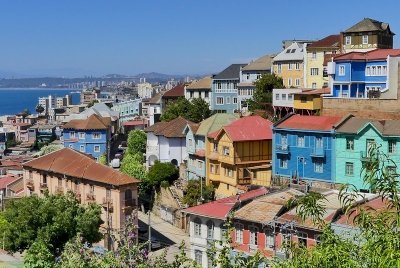
I visited this WHS in 2023 and explored this huge urban sprawl of a seaport city over 3 days. I'm usually not a keen fan of graffiti art but nowadays in Valparaiso it has become part of the city's identity. Whether you like it or not, the graffiti art is constantly changing, so on average every month or two some graffiti you might like or dislike will disappear and change.
The geographic location on steep hills overlooking the Pacific Ocean and the different nationalities of its inhabitants have led to a distinct and innovative urban landscape. The city centre is by the port where you'll find Plaza Sotomayor consisting of buildings from different periods that merge into one big area, with the monument of the heroes of Iquique, one of the oldest hotels in the city, the pretty Edificio de la Intendencia de Valparaíso, the odd modernised and controversial Edificio CSAV (a leading shipping company with a skycraper-like glass extension), and at the northeastern side of the square there are two similar towers, which create a sort of gate entrance to the port from the city.
The steep hills fully covered with colourful buildings, more or less legally built, reminded me a lot of Guanajuato, Mexico. Although I drove in and out of the city a number of times, the best way to explore this city is on foot or by very cheap public transport. Although the 16 remaining ascensores can literally be translated as elevators, only the …
Keep reading 0 comments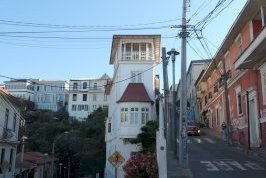
The city of Valparaíso is a very ambivalent city that got poorer and poorer over time. I find the UNESCO inscription a bit difficult to evaluate as the site is mainly the old port area which was one of the richest districts of South America from the 1850s till 1914 and is since then declining (heavily). So parts of the inscription are old, chic houses that formerly were home to rich people and now are home to poor people and that are partially quite rotten. Nevertheless I enjoy Valparaíso as a city a lot. The street art is excellent and fascinating and with it comes an alternative scene culture that I missed a bit after travelling through Patagonia. Also as a Hamburger I love cities with a port which Valparaíso has and is famous for and which can be nicely viewed from e.g. La Sebastiana, one of Pablo Nerudas houses. The inscribed hills (which means in Valparaíso neighbourhoods) Alegre and Concepción are full of street art and also today touristy and nice to walk through. However the Barrio Puerto which is also inscribed is now a poor neighbourhood with Calle Serrano and Plaza Echaurren. Locals will warn you as Gringo not to run through here. However we took a tour and the guides said that they will warn you mainly because they're embarassed by the apperance of the borough. The naval museum is full of history and weapons and is to my opinion way too nationalistic and uncritical but that's …
Keep reading 0 comments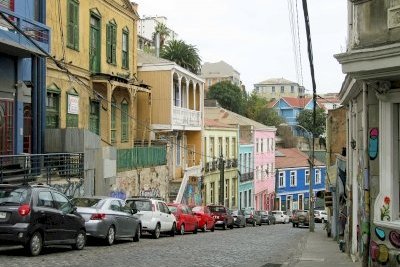
The Historic Quarter of the Seaport City of Valparaiso has seen better days, and now seems just an echo reminding visitors of its heady history as an important stop for seafarers en route to and from Cape Horn. The early 20th century was cruel to the city. First, in 1906, a massive earthquake destroyed large parts of the city (it was a cruel year for cities on the Ring of Fire in the Americas; San Francisco, California, had been destroyed four months earlier). Valparaiso rebounded and rebuilt, ready to welcome back visitors, only to be bypassed in trade by the opening of the Panama Canal in 1914. After visiting Valparaiso, I can't help but picture it as a suitable setting for Charles Dicken's Miss Havisham.
Perhaps I am not giving Valparaiso its due; I did only have a half day to visit the city, and I took part in a tour from Santiago, trying to take advantage of limited time to see as much as possible. The tour started in the upper part of the historic district, and we walked past fine wooden houses, many covered with murals. For every mural, though, there was just as much graffiti. I'm not sure if the graffiti was new, as part of the consistent protests against the Chilean government found in Santiago and other major cities, or whether it had been there for a while. Wandering down the streets, I enjoyed the overlook near the Lutheran Church of Santa Cruz, which offered …
Keep reading 0 comments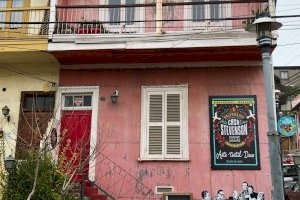
The Historic Quarter of the Seaport City of Valparaiso is both overwhelming (from a traffic perspective) and underwhelming (just looks like a shabby port city) at first - until you go up! However you choose to get there - drive, walk, bus, funicular - just go up. It is one of the most visually stimulating cities that I have ever visited.
A good way to understand the Historic Quarter is on Cerro Concepcion - especially around the Casa Patrimonial area where you can see tons of historic houses indicative of the historic period of the late 19th century while also looking out onto the historic port.
Although the murals of "Valpo" are not technically part of the World Heritage site, they are a must to visit and are located throughout the historic area. There are many tours that focus specifically on the colorful murals but you are guaranteed to stumble upon some of them by simply wandering the hills of Cerro Concepcion and Cerro Alegre.
It is very easy to get to Valparaiso by bus from Santiago (the city or the airport) in about 90 minutes. You can also drive - but beware - it's the first city that ever nearly got the best of me. Google maps doesn't work well because the hills of the city are so vertical that GPS doesn't work well. Also, the streets are generally not marked. Parking is also a challenge.
Valparaiso is considered to be somewhat unsafe at night …
Keep reading 0 comments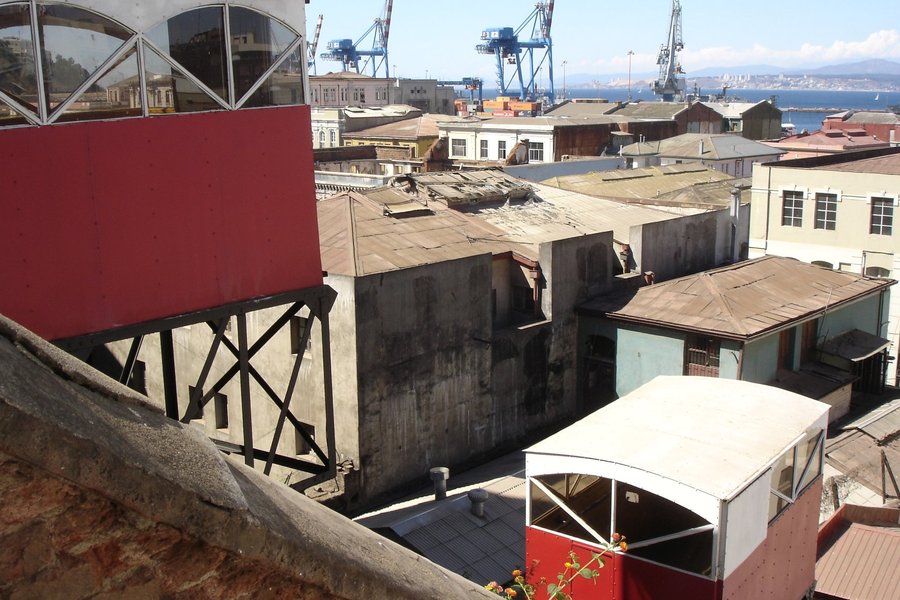
Valpariso is Chile’s second city, and represents a small snapshot of the glory days of pre-Panama canal Pacific trade. Once one of the wealthiest cities in South America, there’s a real sense of a place who’s best days are behind it. I think that adds to it charm. Visiting Valparaiso is an easy 1½ hour bus ride from Santiago, and the slightly rough-around-the-edges port city makes an interesting contrast with the dull urban sprawl of the capital.
At first glance, it’s hard to get a sense of site. The lower town offers little other than claustrophobic but boring streets and too much traffic. The Plaza Sotomayor is a nice open space, and occasionally plays host to the pop-up markets that are common place in any urban centre in Chile. There are a few decent restaurants in this area serving some quality local seafood. But on first impression I found myself feeling a bit disappointed.
However, the real highlight of the town for was the upper town. A sprawling maze of stairs, twisting street and brightly coloured building, this is the real heart of the city. Maps are only of marginal use here, and it can be easy to get lost. It is quite an experience to wander down an nondescript looking alley only to find yourself at yet another stunning vista of the harbour. The vibrancy and colour is only added to by the graffiti. There’s a fun attitude to Valparaiso that I found so lacking in Santiago, …
Keep reading 0 comments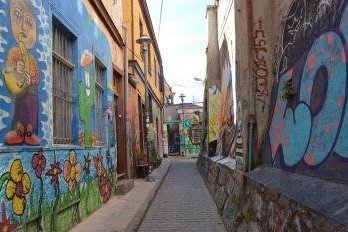
In October 2017, I made a day trip by bus (which run every few minutes) from Santiago to Valparaíso, the dilapidated port city. The city’s golden age was from the mid-nineteenth century until 1914, when the Panama Canal opened — after the canal opened, ships from the eastern United States and Europe could transit the isthmus instead of voyaging around Cape Horn, so fewer ships called on Valparaíso. Nowadays, the former “Jewel of the Pacific” is best known for the graffiti that wallpapers nearly every exposed surface of the ramshackle buildings that line its cobbled streets and alleys.
While I generally avoid walking tours, and, in fact, can't recall having taken any other, I did join Tours 4 Tips "free" (tip only) walking tour (https://tours4tips.com/tour/valparaiso-highlights/) that took in the port city's highlights, including Plaza Sotomayor, the funiculars, the hills of Cerro Alegre and Concepcion, and the "best" graffiti. The streets are labyrinthine and the maps terrible, so it would have been much more difficult to have attempted to find all of these sights without a guide, especially because I had only allotted myself a day in Valparaiso.
Keep reading 0 comments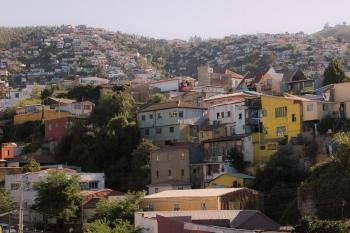
It was once one of the richest metropolises in South America. Its port connected the United States and, to a certain extent, Europe to the natural resources of the southern continent. But an economic crisis with the sale of saltpetre, political changes in the country and, most importantly, the opening of the Panama Canal all took its toll on the financial side of the city.
From those economic ashes, Valparaiso has risen over the decades to become the cultural capital of Chile. The only government department to be based here is the Ministry for Culture, which says something.
Come for the views, stay for the culture. Something like that. Either way, it’s a magical city to get lost in and one you hope you never find your way out of.
Keep reading 0 comments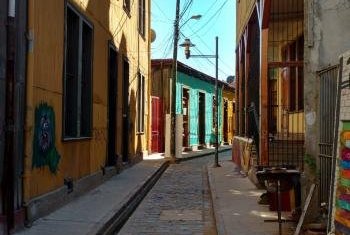
Valparaiso feels like the quirky and cute little sister of grown up and dull Santiago. It’s not as clean, as efficient or as large as Santiago, but it surely makes up in charm and looks. I was wooed within the hour of the city and felt reminded of Porto and Guanajuato with the houses climbing hills and the staircases in the city.
Getting there
If you travel in Chile, plenty of busses will take you to Valparaiso.
For travellers coming in from Santiago, you need to go to metro station Pajaritos. The outbound busses (and the bus for the airport) depart at the South side of the station (inbound North side). Busses for Valparaiso leave frequently (every 15min or so). This is also where you should change if you travel to/from the airport.
You can visit Valparaiso on a layover in Santiago if you have at least 6h to spend (better 7h).
Getting around
Walking is fine. If you are on a tight schedule I would take a bus from the main bus station to Puerto and explore from there.
Notes
- If you want to have a bit of beach vacation, nearby Vina del Mar should be a nice
- Personally, I would skip Santiago and only do Valparaiso.
- If you are returning from Easter Island you can do this on a day trip and then take the next flight out of Santiago in the evening.
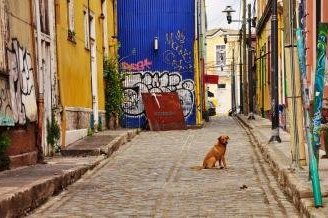
Valparaiso, the seaport of Chile near the capital, Santiago, is a place that really hard to explain as the city is beautiful but at the same time very ugly. When the bus approached the city area, the whole mountain was full of buildings which locals crazily built on the high cliff with small columns supporting the whole structure. At the city center which built on the ground next to the sea, the city gave me a sense of bygone prosperity with many nice buildings since most of them were not in a good shape of preservation. I walked around the city center and did not find anything that worth to mention, except that the cost of living here is a bit cheaper than in the capital.
Then I went to see the upper area of the city. I used a century old funicular instead of climbing the steep streets and ladders. The funicular itself is really interesting, and there are many in this city, strangely that the price to use them are different and the most popular among the tourists are the most expensive. The upper town are really a different city, full of small houses built in many styles and brightly painted, very lovely to see. Most of the buildings are built from rusting galvanized sheet that really gave a sense of poverty, but actually the livelihood is quite good. There are many small streets and stairs linking each level of the city which are unbelievable for theirs …
Keep reading 0 comments
Amazing!Great souvenirs, the stairs, 15 lifts, the old port, the hills, the coloured houses, the restaurants behind the ocean and yum,yum seafood including jumbo Hommards from Robinson Crusoe island and, famous wine.
Very exciting City, full of places to discover as the old downtown, the commercial heart of Valparaiso, the Turry Tower Clock, the museum in Cerro Alegre(Happy Hill)with an imprenable Bay view, Victoria Square with lions and fountain, take a bus to sourround the upper City by Alemania avenue; if you like to walk, expend some time in Cordillera, Alegre, Mariposas Hills(+-44). Other interesting place is Playa Ancha and his Quinta de recreo.
At dark, night clubs welcome those with energy to prolong the pleasure with live shows. Next morning dont forget to enjoy a soup at one its public Markets as Cardonal Mercado!
A Magic City
Keep reading 0 comments
The only disappointing thing we found in Valparaiso was the large amount of restoration work being undertaken. The whole of Serrano Street, the heart of the WHC site, had been dug up, and workers were painstakingly laying new cobble stones along its full length.
The 15 ascensores(lifts) are an intrinsic part of the scene, groaning their way up and down the hillsides, as they have done for over a century, a tribute to the German engineers that built them.
The maze of narrow streets that make up the Upper Town were a delight; a new vista of the harbour opened up around every corner, as well as brightly coloured houses and small eateries.
Keep reading 0 comments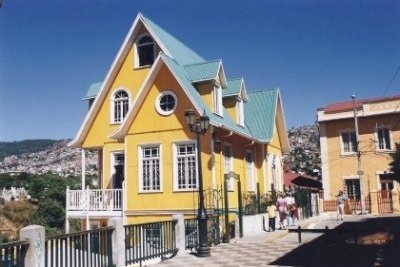
I had heard raving reviews about this city, but it disappointed me at first sight. There is a lot of traffic and smog, and a real town centre is hard to find.
The special thing about this city is the division between its lower and upper parts. Via early 20th century elevators, you can travel between these two worlds. Only about 7 people fit in, and it's quite scary because of the steepness of the hills.
When you arrive in the upper town, a completely different world awaits you: bright colours, artistic buildings, narrow backroads.
Keep reading 0 comments
